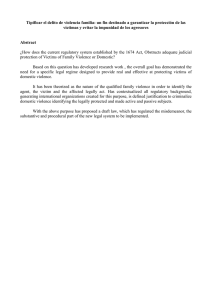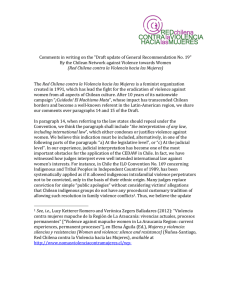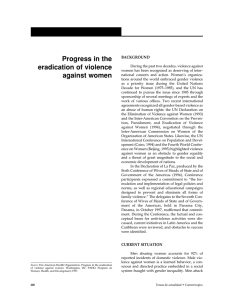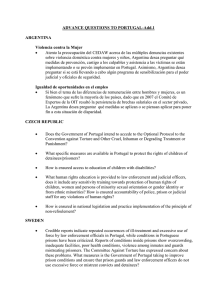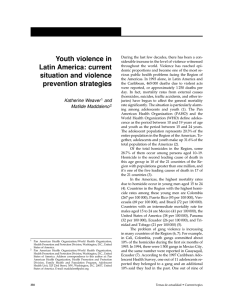English
Anuncio
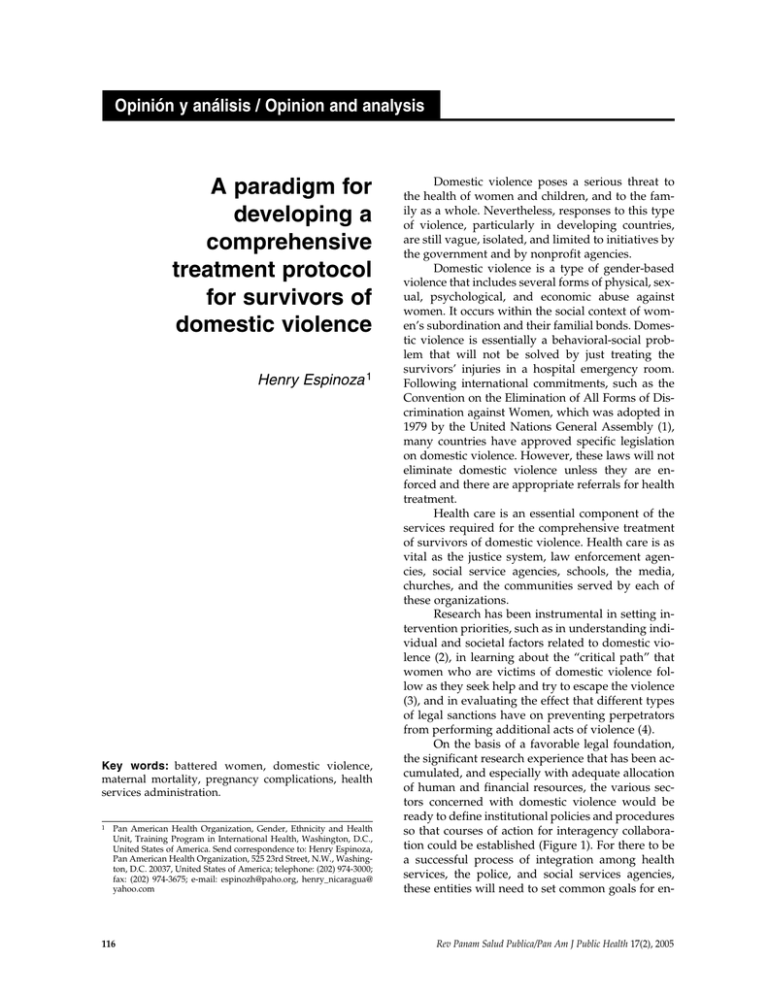
Opinión y análisis / Opinion and analysis A paradigm for developing a comprehensive treatment protocol for survivors of domestic violence Henry Espinoza 1 Key words: battered women, domestic violence, maternal mortality, pregnancy complications, health services administration. 1 Pan American Health Organization, Gender, Ethnicity and Health Unit, Training Program in International Health, Washington, D.C., United States of America. Send correspondence to: Henry Espinoza, Pan American Health Organization, 525 23rd Street, N.W., Washington, D.C. 20037, United States of America; telephone: (202) 974-3000; fax: (202) 974-3675; e-mail: espinozh@paho.org, henry_nicaragua@ yahoo.com 116 Domestic violence poses a serious threat to the health of women and children, and to the family as a whole. Nevertheless, responses to this type of violence, particularly in developing countries, are still vague, isolated, and limited to initiatives by the government and by nonprofit agencies. Domestic violence is a type of gender-based violence that includes several forms of physical, sexual, psychological, and economic abuse against women. It occurs within the social context of women’s subordination and their familial bonds. Domestic violence is essentially a behavioral-social problem that will not be solved by just treating the survivors’ injuries in a hospital emergency room. Following international commitments, such as the Convention on the Elimination of All Forms of Discrimination against Women, which was adopted in 1979 by the United Nations General Assembly (1), many countries have approved specific legislation on domestic violence. However, these laws will not eliminate domestic violence unless they are enforced and there are appropriate referrals for health treatment. Health care is an essential component of the services required for the comprehensive treatment of survivors of domestic violence. Health care is as vital as the justice system, law enforcement agencies, social service agencies, schools, the media, churches, and the communities served by each of these organizations. Research has been instrumental in setting intervention priorities, such as in understanding individual and societal factors related to domestic violence (2), in learning about the “critical path” that women who are victims of domestic violence follow as they seek help and try to escape the violence (3), and in evaluating the effect that different types of legal sanctions have on preventing perpetrators from performing additional acts of violence (4). On the basis of a favorable legal foundation, the significant research experience that has been accumulated, and especially with adequate allocation of human and financial resources, the various sectors concerned with domestic violence would be ready to define institutional policies and procedures so that courses of action for interagency collaboration could be established (Figure 1). For there to be a successful process of integration among health services, the police, and social services agencies, these entities will need to set common goals for en- Rev Panam Salud Publica/Pan Am J Public Health 17(2), 2005 Opinión y análisis • Opinion and analysis FIGURE 1. Paradigm for developing a comprehensive treatment protocol for survivors of domestic violence Sector Levels/ Actions Health care: – Government – For-profit – Nonprofit Police and Justice Primary prevention (e.g., health centers): – Promotion – Information dissemination Other sectors: – Education – Churches – Local government – Media – Neighborhoods Secondary prevention (e.g., district hospitals): – Screening and data collection – Treatment and protection – Referrals Tertiary prevention Institutional policies that allow agencies to set common goals, objectives, strategies, and indicators Knowledge of domestic violence Allocation of human and financial resources National legislation to address domestic violence hancing the quality of services (5) and to consider a paradigm for primary, secondary, and tertiary prevention activities and for the measurement of immediate and long-term outcomes. Despite the great enthusiasm of participating agencies, interagency collaborations on the issue of domestic violence have led to few concrete outcomes (6). In the United States of America a traditional epidemiological model of preventions has been proposed for law enforcement agencies (4). If primary, secondary, and tertiary prevention measures are applied in all the sectors concerned with domestic violence, the resulting paradigm (Figure 1) will work well for all the sectors, provided that there is a legal foundation, there are adequate resources, and there are clear objectives, strategies, actions, activities, and indicators defined for each sector. An epidemiological public health approach is feasible as an operational model of interagency collaboration, but agencies will need to define procedures and standards of treatment according to the objectives of each type of Rev Panam Salud Publica/Pan Am J Public Health 17(2), 2005 prevention activity. Some general objectives of primary, secondary, and tertiary prevention in domestic violence include, respectively, preventing violence, providing treatment and prolonging life, and repairing damages or paying for the cost of that. Interagency collaboration on domestic violence will seek to maximize resources, reduce women’s suffering, and avoid duplication of efforts, including data collection. To achieve these objectives, agencies will need to further define referral and information systems. If appropriate, agencies should also develop treatment protocols according to the level of care that a facility provides. For instance, in the case of the health sector, hospitals could have a more complete treatment protocol than primary health clinics would. Many of the actions related to information dissemination, screening, treatment, and other activities within the three prevention levels have already been defined for the health sector response to domestic violence in developing countries (2, 7). Research that consists of 117 Opinión y análisis • Opinion and analysis regularly screening to identify domestic violence cases among women visiting health clinics for other medical reasons is a good example of what the health sector can do in the area of prevention (8). However, outside of the area of research, many health care program directors may face challenges, fears, and pressure in responding to domestic violence. For instance, these directors may implement routine screening for domestic violence before reaching agreement with the police on reporting, referrals, and other key issues. Finally, despite all the willingness of ministries of health, neither courses of action in each of the sectors nor successful comprehensive services for domestic violence survivors will be established spontaneously. What willing ministries of health can do is to seek an official, legitimate leadership role in guiding a multisector prevention approach. Based on the experience that the Pan American Health Organization has had with research on domestic violence in Latin America, it is recommended that multisector commissions be created with the primary role of supervising and documenting progress towards the development and implementation of a comprehensive treatment protocol (7). In any case, interagency collaboration is necessary to establish comprehensive, multidisciplinary, transsector treatment for domestic violence survivors and for those who perpetrate the violence. SINOPSIS Paradigma para crear un protocolo terapéutico integral destinado a las sobrevivientes de violencia doméstica En este trabajo se propone un paradigma para crear un protocolo terapéutico integral destinado a las sobrevivientes de episodios de violencia en el hogar. El paradigma propuesto exige que las organizaciones y grupos sociales que más tienen que lidiar con la violencia doméstica tengan una mayor participación en este sentido y una mayor vinculación entre sí. La atención sanitaria es un componente indispensable del tratamiento integral de sobrevivientes de la violencia doméstica, como también lo son el sistema jurídico, las agencias que velan por el cumplimiento de la ley, las agencias que proveen servicios sociales, las escuelas, los medios de difusión y las iglesias. Para que los servicios estén bien integrados, tanto las agencias como las comunidades donde estas agencias prestan sus servicios tendrán que llegar a un común entendimiento del problema de la violencia doméstica, compartir metas y tener un mismo paradigma de trabajo conjunto. Un paradigma de este tipo podría comprender la puesta en marcha, mediante una colaboración entre agencias, de actividades de promoción, prevención, tratamiento y seguimiento de sobrevivientes, y de medición de resultados inmediatos y en el largo plazo. Palabras clave: mujeres maltratadas, violencia do- Acknowledgments. I am grateful for the comments given on this paper by Elsa Gómez, Gayle Gollop, and Dinys Luciano, of the Pan American Health Organization. méstica, mortalidad materna, complicaciones del embarazo, vigilancia de la población, administración de los servicos de salud. REFERENCES 1. United Nations, Division for the Advancement of Women. Convención sobre la eliminación de todas las formas de discriminación contra la mujer [Internet page]. Available from: http://www.un. org/womenwatch/daw/cedaw/text/ sconvention.htm. Accessed 1 August 2004. 2. Heise L, Ellsberg M, Gottemoeller M. Ending violence against women. Baltimore: Johns Hopkins University School of Public Health, Population Information Program; 1999. (Population Reports, Series L, No.11.) 3. Sagot M, Shrader E. La ruta crítica de las mujeres afectadas por la violencia intrafa- 118 miliar en América Latina: estudios de caso en diez países. Washington, D.C.: Organización Panamericana de la Salud; 2000. 4. Kruttschnitt C, McLaughlin BL, Petrie CV, eds. Advancing the federal research agenda on violence against women. Washington, D.C.; National Academies Press; 2004. 5. Chalk R, King P, eds. Violence in families: assessing prevention and treatment programs. Washington, D.C.; National Academies Press; 2003. 6. Hague G. Multi-agency initiatives. In: Taylor-Browne J, ed. What works in re- ducing domestic violence? Concord: Whiting & Birch; 2001. Pp. 275–306. 7. Velzeboer M, Ellsberg M, Arcas CC, GarcíaMoreno C. Violence against women: the health sector responds. Washington, D.C.: Pan American Health Organization; 2003. 8. Guedes A, Bott S, Cuca Y. Integrating systematic screening for gender-based violence into sexual and reproductive health services: results of a baseline study by the International Planned Parenthood Federation, Western Hemisphere Region. Int J Gynaecol Obstet. 2002;78 Suppl 1:S57–63. Rev Panam Salud Publica/Pan Am J Public Health 17(2), 2005
